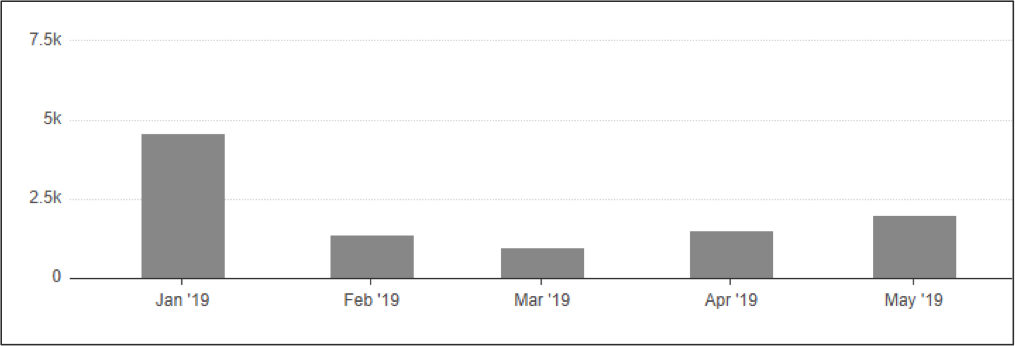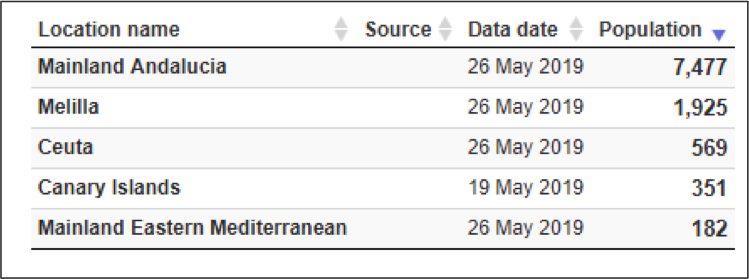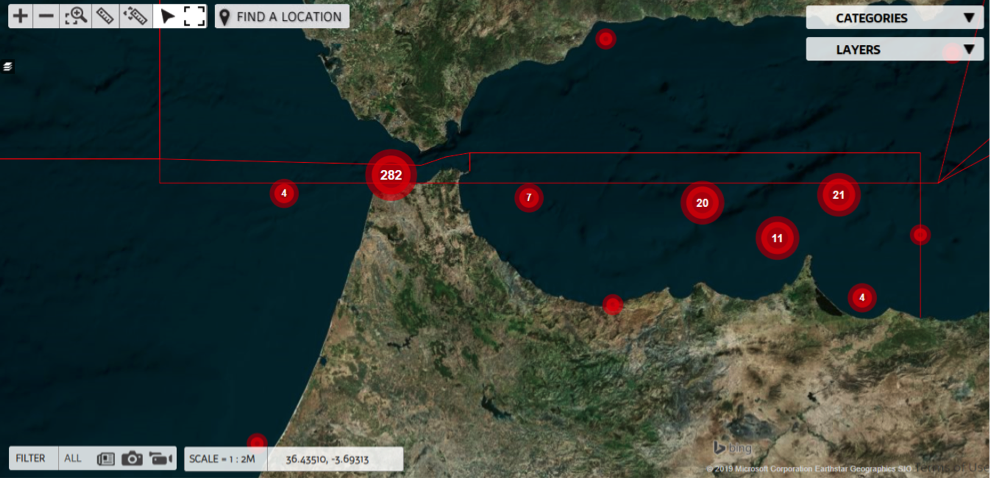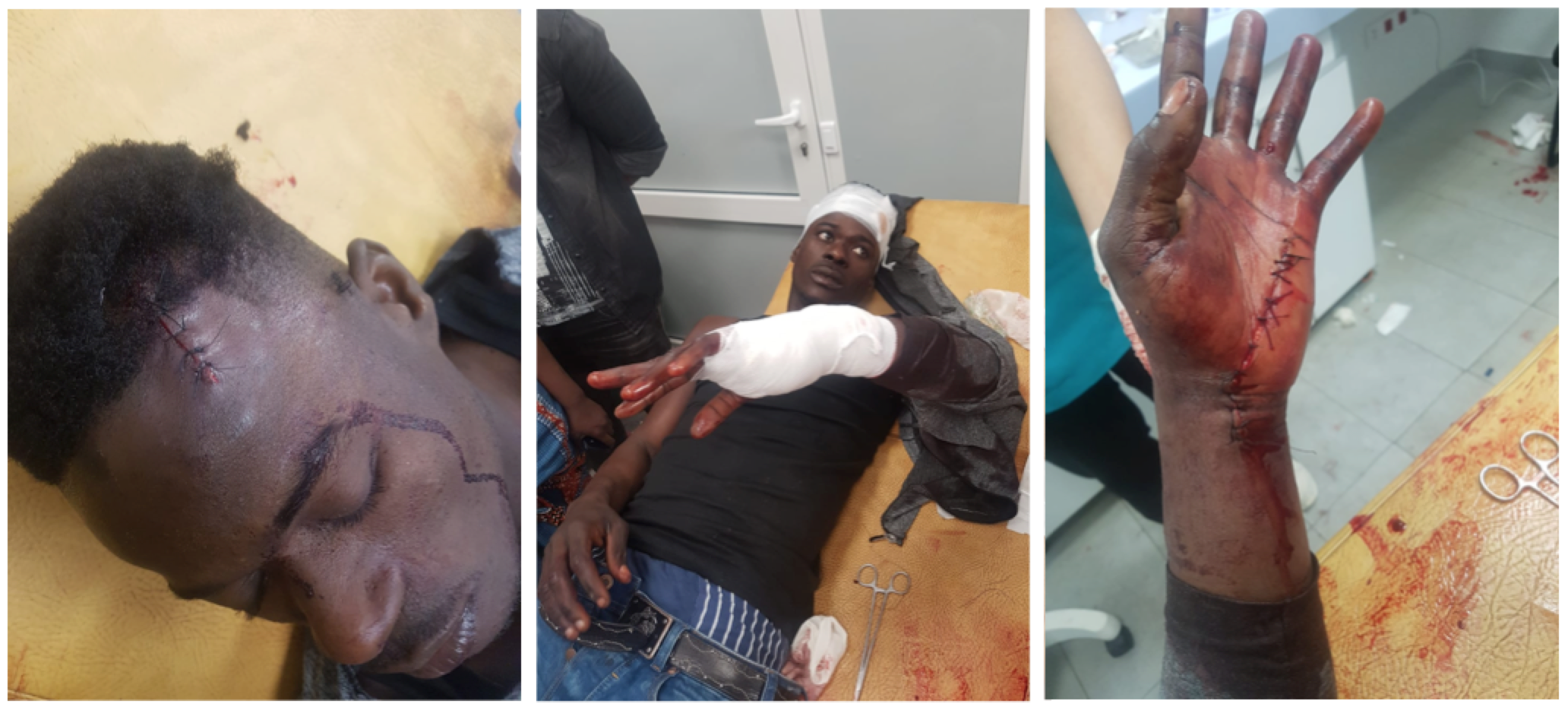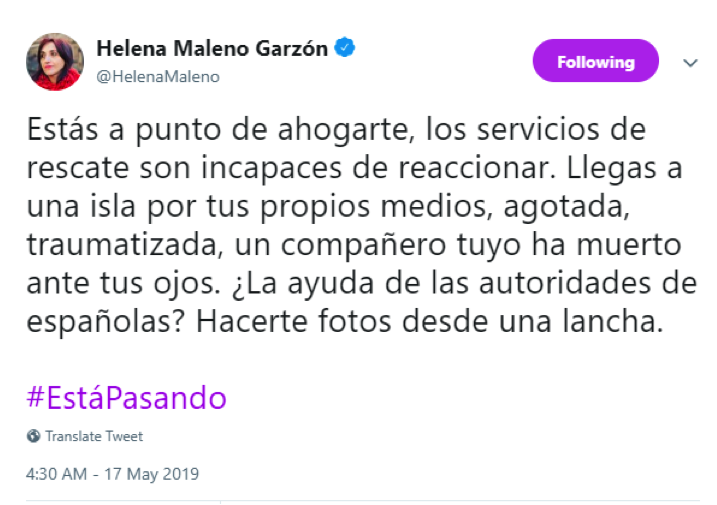Detained travellers in the commissary of Bni Mkada, Tangier. Source: activist
Introduction
Since August/September 2018, we have witnessed a constant exacerbation of the situation of travellers in transit on the Western Mediterranean route. Violence and the threat of detention is a constant reality for sub-saharan travellers. The title is taken from the testimony of an AP member who was arrested and beaten in Tanger. The assault was witnessed by another comrade (see below). Her experience is just one example of police violence and unlawful arbitrary repression in Morocco. Unfortunately, this is part of the violent structures imposed by the Moroccan state at the behest of the European Union. We will not stop making visible and denouncing this structural violence!
Not only do the raids and violent and arbitrary arrests of black people continue on a large scale, but the sea passage from Morocco to Spain has become more dangerous since new political sea rescue directives where put into practice by the Salvamento Maritimo, the Spanish rescue authority.
This report attempts to give an overview of the major developments in Morocco as both a transit country and country of origin. It also attempts to summarize the political developments of the border regime in the Western Mediterranean.
Key figures and findings
A total of 7,465 travellers arrived on Spanish shores by boat from 1 January to 15 May this year. This is 24.2% more than in the same period in 2018, according to the Spanish Interior Ministry.[1] We see a sharp decline in arrivals from January (4612 arrivals) to February (1.366) and March (only 995 arrivals), a development that Spanish Interior Minister, Grande-Marlaska, stressed on various occasions as he crowed about his attempts to thwart immigration. Numbers rose again in April (1,539) and May (1.992 until May 26th). [2]
Sea and land arrivals to Spain 2019. Source: UNHCR // https://data2.unhcr.org/en/country/esp
The arrivals to the enclaves of Ceuta and Melilla declined in comparison to the same period in 2018, whereas the maritime routes saw a rise of more than 27 %. The maritime route that has experienced the greatest growth is the route towards the Canary Islands. 351 people have arrived at the islets so far this year, which is 234.3% more than in the same period in 2018, when only 105 travellers managed to reach the Canaries.[3]
Location of arrivals to Spain in 2019, land and sea.
Source: UNHCR // https://data2.unhcr.org/en/country/esp
During the period covered in this report, the Alarm Phone has worked on 26 distress situations in the Western Mediterranean Sea. 21 boats were returned to Morocco while 5 made it to Spain. See the case reports here.
Source: Watch the Med Alarm Phone // http://watchthemed.net/
In all the previous report periods, around 50% of the boats AP was in contact with managed to reach Spain, but in this period the figure was closer to 20%. This illustrates the new reality in the Western Mediterranean. In a press conference on 23rd of May, the Moroccan government highlighted its efforts to curb irregular migration. The Moroccan spokesman, minister Mustafa Jalifi, announced Morocco had thwarted more than 30,000 attempts to emigrate to Spain so far this year.[4] The figure cannot be confirmed and does not display an accurate picture of the number of people in transit in the Western Med, as many travellers have been intercepted several times and hence have been counted more than once, but nevertheless this high number given for interceptions tallies with experiences on the ground. On 25th and 26th of May alone, the Marine Royale intercepted 249 travellers, according to what ‘military sources’ told MAP, the Moroccan Press Agency.[5]
As he boasted about the current interception figures, Jalfi praised the efforts of Morocco in mobilizing human resources and finances for the operations.[6] 7 months ago, a one-time disbursement of 140 million euro to Morocco had been agreed upon, but the funds have not yet been transferred in their entirety. Jalfi’s words were a clear hint, addressed to Spain and the European Union, to ensure the ‘payment’ of its watchdog at the South-western EU border. Probably in response, Spanish politicians have again raised demands at the European Commission to reinforce financial flows to Morocco, proposing fundings fixed for several years that would amount to 50 million euro annually.[7] Nevertheless, it is important not to oversee that the interests of the Kingdom of Morocco cannot be reduced to the financial benefits of cooperation with the EU in the field of migration policy. There is much more at stake here, the economic and political component is around Western Sahara and Morocco’s policies on “security and terrorism” is also a primary concern for Morocco international wise and within the African Union (AU). For Morocco it is also about possibilities of mobility for its own population and thus about powerful positions in the international context.
Ongoing repression and detention in Morocco: testimonies
Not only in the transit hubs Nador and Tanger but also in cities much further inland and far away from the EUropean sea or land border, black people still suffer from ongoing repression, detention, refoulement and the constant fear of being expelled or deported to their country of origin. During the period covered in this report, we continuously collected information about police operations in multiple Moroccan cities including, Rabat, Fes, Oujda and Agadir.
In the forests around Nador, the police operations intensified during March and April, with the military raiding the makeshift camps of travellers every night, barely allowing anyone to sleep. Nador itself is like a city from which Sub Saharans, with or without residence permits, are banned. Since the beginning of Ramadan however, local contacts noted that the situation has calmed down and, by and large, only the people apprehended at sea or during attempts to jump the fence to Melilla are arrested and refouled. It remains to be seen how police operations will continue after the end of Ramadan.
At the end of March, Senegalese detainees managed to document their situation and publish a video from out of the cell where they had been kept in disgusting conditions for at least two weeks. They decided to start a hunger strike calling on the Senegalese authorities to act to end their detention. We couldn’t find out more about what eventually happened to them, but the video is a crucial documentation of the circumstances under which Sub-Saharan travellers have to endure their arbitrary detention. See the video here.
On Sunday 19th of May, an AP member was arrested in Tangier during a police raid in a residential area. He was in an apartment with several people, among them two children and woman who had just given birth. The police arrested everyone but the new mother and the children. They also took the mother of the two infants. Our comrade was eventually separated from the mother. He reports that he was brought to a commissary out of town, where he met other detainees who had been waiting in the commissary for 10 days for whatever to come. Our comrade was eventually handcuffed and refouled to a small village close to Rabat, from where he managed to travel back to Tanger. He is back at the apartment where the kids and the woman who had just given birth are still struggling, unsupported, with the challenges of everyday life as a black person in Tanger. No other person arrested in the flat had returned, also the mother of the kids was still missing when this report period ended.
Another testimony from two AP members also shows the extent of violence detainees have to endure during their detention:
On Tuesday 21st of May, two Alarm Phone members were arrested in the streets of Tangier while they were buying food. Both have a regular legal status in Morocco. This was ignored by the officers. The two women, one of them 5 months pregnant, were violently forced, despite their protests, onto one of several buses that the Moroccan police had placed in one of the bigger streets in Tangier center with express purpose of ‘collecting’ black people in the streets. Our comrades were brought to a commissary. When one of them resisted entering a ‘small, dirty and very dark room’ several policemen started beating her. When they caught our other member filming the violence with her phone, they beat her as well and confiscated the phone. Both women were injured and the officers called an ambulance which took them to the hospital from where they finally managed to escape.
It is not only the authorities (directly) who are a constant threat to Sub-Saharan travellers, but according to local contacts, racist motivated violence rose again significantly during the month of Ramadan. A high number of incidents were reported where black people were attacked and injured heavily. This case, where two men had to be hospitalised after being attacked in Boukhalef, Tanger, is typical:
Violent attacks in May in Boukhalef, Tangier. [8] Source: activist
On 25th of May, a group of 7 persons, among them 3 women, testified to AP Tanger that they were attacked, the women raped and one woman injured with a knife. The aggressors took all their belongings, phones and money. No one had intervened.
Our contacts suggest that these kind of attacks are not only tolerated but even encouraged by the local police in order to deter people from staying in Tangier, one of the most tense migration hubs in Morocco.
In the light of the fact that thousands of migrants, regardless of sex, age or health, are literally sent into the desert in the south of Morocco on a regular basis, we strongly denounce the Moroccan forces ripping families apart and leaving vulnerable people in highly precarious situations by destroying their social networks. The refoulements are a disgusting policy of deterrence. It is an attempt to thwart onward migration for those who have no place to which they can ‘go back’. It creates nothing but constant suffering for the people concerned! The arbitrary violence of the officers and the constant practical violations of Moroccan law itself during the detentions are widely known, well documented, never challenged but rather ‘overseen’ by European officials. This brutality of police raids in the north strongly depends on the influence of Europe asking for Morocco to tackle migration issues.
We will continue to collect, visibilize and denounce the structural and continuous violence ignored, tolerated, and even envisaged and executed by the agents of the border regime.
Nevertheless, in Morocco is not simply a discourse in favour of a simple anti-migrant rhetoric at play. Rather, deportation and displacement, brutal police raids ultimately enforcing anti-migrant politics, flourish within a schizophrenic Moroccan context of migration politics. At the same time campaigns of legalisation are taking place, the National Strategy of Immigration (SNIA) of the Moroccan government leads to the statement of being a country of immigration. Also International Actors promote their programs of humanitarian aid or Integration for people on the move. Yet one could conclude that the brutal anti-migrant practice legitimizes itself around a humanitarian discourse.
Situation at the land border: The Spanish colonies Melilla and Ceuta
Boza at Melilla
On 12th of May, 52 people managed to jump the fences to Melilla and enter Spain. About a hundred of people had stormed the fence collectively, but nearly half of the group was intercepted or pushed-back to Morocco by the Spanish Guardia Civil and the Moroccan “Forces Auxiliaires”. This was the first successful collective jump of the Melilla fences since October 2018. The “Association Marocaine de Droit de l’Homme” (AMDH), based in Nador, denounced the push-back of at least 20 travellers from Spanish territory.[9] These practices, known as ‘devoluciones en caliente’/ ‘hot deportations’, have been condemned by the Court of Strasbourg (e.g. in a judgement of 3rd October 2017[10]) but are still applied by the Spanish authorities.[11] Interestingly, even the Asociación Unificada de Guardias Civiles (AUGC) states that “Hot returns do not comply with the law since the national territory begins once the immigrant crosses the fence”.[12]
All of the travellers who had managed to escape from the border police immediately applied for asylum, probably fearing to be deported en masse back to Morocco otherwise. This is exactly what had happened to a group of 116 travellers that had successfully arrived in Ceuta on 22nd of August 2018.[13]
The Spanish right wing party VOX is now trying to sue the 52 travellers who had reached Melilla and have been held in the reception center, the CETI, since their arrival. The legal deputy secretary of Vox in Melilla, Felipe Castillo, announced on Friday 17th of May at a press conference the filing of a criminal complaint which calls for the identification of the 52 immigrants, their detention and prosecution for criminal organization and disorderly conduct, among other charges.[14] Bearing in mind the illegal push-back practice once again applied during the jump by the Guardia Civil, it is even more ironic to sue travellers simply trying to enact their right to seek for protection.
The ‘Anti -Migrant- Trap’ at Ceuta
Under the Moroccan fence being constructed around Ceuta with EU monies, there is a human-made ravine and, 50 metres further on, before reaching the Spanish double fence, there is a two-metre ditch that, according to rumours, was originally planned to be filled with concertina barbed-wire. NGOs already call it the “trampa anti-migrantes” (“anti-migrant trap”).[15]
At the Ceuta port fortification also continues: By the end of the year, the port will be completely shielded from migratory pressures. A wall will be constructed that is more than 4 metres high with the main objective being to block travellers that try to embark on boats towards Algeciras in order to escape their open-air prison of Ceuta. The port entry will have a double door system where the second door is only opened after the first one is closed, like a watergate. Total costs amount to €2,7 Mio. [16] Until the fortification is completed, the Guardia Civil and National Police continue to try to control the port area. On 18th of May, the Guardia Civil launched a major operation at the port, arresting around 80 travellers of Moroccan origin, among them 28 minors. 19 of the minors had already been registered at the center of minors ‘La Esperanza de Hadù’ but had escaped from there in order to try to reach mainland Spain. The adults were transferred to the National Police and will be expelled to Morocco via Tarajal.[17]
Salvamento and Sea Rescue developments
In Summer an increase in arrivals of travellers who risk their lives in the sea crossings towards Spain can be expected. Salvamento Marítimo faces this prospect with wage cuts in their air equipment – subcontracted by a British company -, strikes called by their workers, complaints of insufficient crews in the rescue boats and the long breakdown of radars that facilitate the search for people in danger at sea.[18]
According to several news reports, the Spanish government has once more increased pressure on the Spanish search and rescue organisation, Salvamento Maritimo (SM). Despite the likely rise in attempts to cross the Western Mediterranean over the coming months due to improving weather conditions, SM staff has been cut and the remaining staff will be forced to work even more. These cuts have been denounced as ‘brutal’ by CGT, the Spanish labour union, and as a ‘political strategy’ intending to reduce the arrival of migrants in Spain.[19]
Ismael Furió, long-term staff member of Salvamento Marítimo and now secretary of the CGT’s Sea and Ports Sector organization, gave a lot of interviews denouncing the worsening conditions for the staff of Salvamento: Before, each rescue asset had been operated by three different crews and in shifts. Currently there are only 2 crews for each boat, which means that the teams have to do three shifts of 24 hours in a row each, which is unbearable.[20] In May, but throughout the year already, the pilots of Salvamento were also on strike to improve their working conditions.[21] [22]
Patricia Simon, a journalist of ‘La Marea’ specialising in migration, talks about a new directive from the Spanish government to Salvamento, stating that, in certain cases, SM should not rescue detected travellers in distress, but simply monitor the situation until the Moroccan Marine Royale arrives. This directive also covers distress cases in the Spanish zone. Simon further reports that this practise is now put in place in all Andalusian coastal areas.[23]
This means that the “hot deportations” (“devoluciones calientes”), which have been going on for years at the terrestrial borders of the Spanish colonies Ceuta and Melilla years, are now a reality in the waters as well.
Ismael Furió reveals as well that in the case of the Tarifa unit, one of the most active because it is in the Strait of Gibraltar, now, when it goes out to rescue, “the order is to keep the boat [in distress] on one side until it is picked up by the Moroccan Coast Guard”.[24] According to the CGT, SM Tarifa had in several cases played “cat and mouse” for hours with boats found in the Strait of Gibraltar until the Moroccan Navy arrived and intercepted the travellers.[25] This is an unacceptable practice and has been criticised by several Spanish organizations.
The dubious and dangerous collaboration between the Moroccan and Spanish SAR stakeholders were clearly and disgustingly illustrated on Friday 17th of March, where 7 survivors of a shipwreck in the Alborán Sea had managed to arrive at the historically contested Spanish island, Isla de Perejil.[26] After hours of distress in the presence of Spanish aerial and naval assets, they were eventually returned to Morocco. The travellers reported to the NGO Caminando Fronteras that one of their comrades had fallen into the sea while they were calling out for help. Even though the situation had been very dangerous for all of them, SM would not intervene. Helena Maleno finds the right words in her tweet: “You’re about to drown, the rescue services are unable to react. You arrive on an island by your own means, exhausted, traumatized, a companion of yours has died before your eyes. The help of the Spanish authorities? To take pictures of you from a boat.”
Source: Twitter // https://twitter.com/HelenaMaleno/status/1129348384882606080
The circumstances and the legal framework under which the travellers were picked up by the Moroccan Navy are unclear, as the island is under Spanish jurisdiction. Grande-Marlaska later stated that the return of the travellers to Morocco was legitimate, arguing that they had been picked up from the shared rescue zone.[27][28]
Under the authority of the Spanish military police, the Guardia Civil, SM is also forced to disembark rescued migrants, not at the closest Spanish port, but at places where the Guardia Civil tells them to – which often means greater distances and prolonged suffering for the rescued and a rescue vacuum in the absence of SM assets.
Clearly, these novel strategies by the Spanish government further endanger the lives of those escaping from Morocco and are cynical attempts to block migration by any means available.
Lethal impacts of the border regime: documentation of incidents
Up to May 29th, 164 deaths have been recorded in the Western Mediterranean by Missing Migrants Project[29]. The estimated number of unregistered fatalities is certainly much higher. In comparison: Throughout the whole year of 2018, 218 fatalities were documented in the same area. This shows that the crossing is increasingly dangerous for travellers. The numbers only refer to incidents at sea and don’t take into account the numerous loss lives of travellers in transit on Moroccan ground, mostly undocumented, but also a direct consequence of the European border regime which forces people on to life-threatening migration routes. We cannot provide an exhaustive documentation of fatalities in the Western Mediterranean Region, but we want to make the lethal effects of the border politics visible. What follows is a list of crucial but typical incidents on the Western Mediterranean Sea crossing.
| On 18th of March, the Moroccan Marine Royale rescued a boat carrying 56 people in the Alboran Sea, among them 3 dead persons.[30]
~ On 19th of March, a dead body was recovered off Melilla.[31] ~ On 22nd of March, the body of a woman of sub-saharan origin was found at the beach of Melilla. [32] ~ On 18th of March, the Moroccan Marine Royale rescued a boat carrying 56 people in the Alboran Sea, among them 3 dead persons.[30] ~ On 19th of March, a dead body was recovered off Melilla.[31] ~ On 22nd of March, the body of a woman of sub-saharan origin was found at the beach of Melilla. [32] ~ On 26th of March, a body was washed ashore at Tarajal, Ceuta. He could not be identified.[33] ~ On 1st of April a man died, supposedly from hypothermia, after being rescued from a rubber boat carrying in total 13 travellers. He had been transferred to Tarifa but died shortly after the disembarkation.[34] ~ On 2nd of April, a decomposed body was found by fishermen and brought to Nador, Morocco.[35] ~ On 22nd of April, 4 travellers died in a shipwreck of a boat carrying in total 13 passengers. The 9 survivors had been picked up by the Moroccan Marine and brought to a hospital in Cassiago, Morocco.[36] ~ The same day, 22nd of April, travellers report to Alarm Phone that a convoy had capsized in the Strait of Gibraltar with 4 survivors only from a convoy of 8 people. Circumstances are unclear. ~ On 26th of April, 18 travellers of Sub Saharan origin died in a car accident close to Berkane, Morocco, among them 17 men and one woman. 17 injured people were transferred to the hospital.[37] ~ On 1st of May, a pregnant woman drowned close to Cap Spartel, while 4 survivors were rescued by the Moroccan Marine.[38] The same day, another shipwreck occurred. The survivors testified to the Alarm Phone that only 3 people were rescued from a boat initially carrying 13 passengers.[39] ~ On 2nd of May, 4 travellers died when their boat capsized in the Strait of Gibraltar after having been in the water for more than a day. The 8 survivors were rescued by fishermen.[40] ~ On 3rd of May, the body of a estimatedly 30-40 years old woman was found at the Moroccan beach of Tetuan.[41] ~ On Saturday, 4th of May, the body of a young Senegalese national has been found one mile off the port of Algeciras. The man was eventually identified by his brother. [42] ~ On 10th of May, two bodies were found at the Spanish coast. The body of a woman was washed ashore at Playa de Castilnovo, Cádiz, and the body of a boy was found between El Palmar and Mangueta. The bodies are probably related to a shipwreck that occurred on 8th of May, when a wave turned a rubber boat carrying 26 passengers and a woman and a minor went missing in the sea. ~ On 22nd of May, three women drowned while 69 survivors were intercepted by the Moroccan Marine Royale in the Strait of Gibraltar.[43] ~ On 28th of May, a woman from Ivory Coast lost her life trying to reach Spain in a boat carrying 12 passengers. The 11 survivors were taken back to Morocco. The woman’s body was taken to Tanger morgue, where she could eventually be identified. ~ On 29th of May, Helena Maleno reports two missing people from a boat of initially 7 passengers that was rescued by Salvamento Maritimo.[44] |
Footnotes
[1] https://eltorotv.com/noticias/espana/7-500-inmigrantes-llegan-a-espana-en-patera-en-lo-que-va-de-2019-un-242-mas-que-en-2018-20190521
[2] https://data2.unhcr.org/en/situations/mediterranean/location/5226 ).
[3] https://eltorotv.com/noticias/espana/7-500-inmigrantes-llegan-a-espana-en-patera-en-lo-que-va-de-2019-un-242-mas-que-en-2018-20190521
[4] https://elfarodeceuta.es/marruecos-afirma-aborto-30000-salidas-emigrantes-espana-2019/
[5] https://www.huffpostmaghreb.com/entry/migration-en-un-week-end-la-marine-royale-porte-secours-a-249-subsahariens-secourus_mg_5cec0b6be4b00356fc25cba5?ncid=other_facebook_eucluwzme5k&utm_campaign=share_facebook&fbclid=IwAR17YUOefMGTiNOtUWc1P7Fcve88JQ65YmC61h9IWbLyvDe4qG7MzOyOn9g
[6] https://elfarodeceuta.es/marruecos-afirma-aborto-30000-salidas-emigrantes-espana-2019/
[7] https://elpais.com/politica/2019/05/24/actualidad/1558721313_924409.html
[8] The persons on the pictures confirmed that they want to denounce / publish about the incident.
[9] https://elpais.com/politica/2019/05/18/actualidad/1558181440_077467.html
[10] https://www.asylumineurope.org/news/03-10-2017/spain-collective-expulsion-condemned-strasbourg-court
[11] http://www.rtve.es/noticias/20190512/salto-valla-melilla/1935700.shtml
https://www.dw.com/en/migrants-force-entry-in-spains-melilla-exclave/a-48710227
https://www.elmundo.es/espana/2019/05/12/5cd7eb0cfdddff66868b45be.html
[12] http://www.ceutaldia.com/articulo/sucesos/augc-pide-marlaska-protocolo-claro-fronteras-ceuta-melilla/20190513174454200434.html
[13] https://www.diariosur.es/nacional/interior-deporta-marruecos-inmigrantes-entraron-ceuta-20180823150214-ntrc.html
[14] https://www.elmundo.es/espana/2019/05/17/5cdee865fc6c836c6d8b45c4.html
[15] https://www.elmundo.es/espana/2019/04/02/5ca2591e21efa0bc3a8b4695.html
[16] https://elfarodeceuta.es/muro-mas-4-metros-dobles-puertas-claves-blindar-puerto-ceuta/
[17] https://elfarodeceuta.es/redada-puerto-80-inmigrantes-interceptados/
[18] https://www.eldiario.es/desalambre/Salvamento-Maritimo-trabajadores-aereos-empresa_0_898710290.html
[19] https://www.europasur.es/campo-de-gibraltar/cgt-recorte-personal-salvamento-maritimo_0_1348965460.html
[20] http://salvamentomaritimo.org/noticias/entre-vista-a-nuestro-companero-ismael-furio/
[21] https://www.diariocordoba.com/noticias/sociedad/huelga-pilotos-salvamento-maritimo_1301806.html
[22] https://www.lavozdegalicia.es/noticia/maritima/2019/05/08/pilotos-helicopteros-salvamento-maritimo-huelga/00031557321986814898748.htm
[23] https://www.youtube.com/watch?v=JCxFa0jCe0I
[24] http://salvamentomaritimo.org/noticias/entre-vista-a-nuestro-companero-ismael-furio/
[25] http://salvamentomaritimo.org/noticias/nueva-formula-de-devolucion-en-caliente-salvamento-maritimo-custodia-pateras-para-que-las-rescate-marruecos/
[26] https://twitter.com/walkingborders/status/1129485032983277568
[27] https://www.eldiario.es/desalambre/Gobierno-supervivientes-naufragio-Perejil-Marruecos_0_900111052.html
[28] In 2014, a similar incident was documented, when 13 travellers had arrived on the island of Perejil and several Moroccan soldiers had entered the island to return the new arrivals to Morocco. At the time, the Spanish Ministry of the Interior had justified the operation with the existence of a “verbal agreement” adopted between the two states concerning arrivals at the Spanish islet.
[29] https://missingmigrants.iom.int/region/mediterranean?migrant_route%5B%5D=1378
[30] https://twitter.com/HelenaMaleno/status/1107542506781265920
[31] https://www.lavanguardia.com/vida/20190319/461132822302/hallan-en-la-costa-de-melilla-el-cadaver-de-joven-con-un-chaleco-salvavidas.html
[32] https://elfarodemelilla.es/hallan-horcas-coloradas-melilla-cadaver-mujer-segundo-3-dias/
[33] http://www.ceutaldia.com/articulo/sucesos/temporal-saca-fondo-mar-cadaver-tan-descompuesto-sabe-es-hombre-mujer/20190326201519197462.html
[34] https://www.europasur.es/tarifa/Tarifa-muere-migrante-Estrecho_0_1341766207.html
[35] https://www.facebook.com/AmdhNador/posts/2302608666618062
[36] https://www.eldiario.es/desalambre/personas-naufragios-marroqui-Caminando-Fronteras_0_894861067.html
[37] https://www.bladi.net/maroc-morts-clandestins-canal,55603.html
[38] https://www.eldiario.es/desalambre/personas-naufragios-marroqui-Caminando-Fronteras_0_894861067.html
[39] https://alarmphone.org/en/2019/05/06/witness-testimony-shipwreck-alarm-phone-migrants-morocco-spain/
[40] https://www.eldiario.es/desalambre/personas-naufragios-marroqui-Caminando-Fronteras_0_894861067.html
[41] https://elfarodeceuta.es/tragedia-migratoria-varias-personas-muertas-naufragio-embarcaciones/
[42] https://www.lavozdigital.es/cadiz/provincia/lvdi-21-anos-peluquera-senegal-identidad-cadaver-escupio-ayer-costa-cadiz-201905051517_noticia.html
[43] https://www.eldiario.es/desalambre/Mueren-mujeres-naufragio-patera-Estrecho_0_901860170.html#click=https://t.co/u0UsfYtJXX
[44] https://twitter.com/HelenaMaleno/status/1133831038461988865

